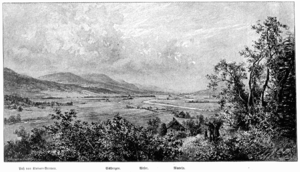Battle of Idistaviso
| Battle of Idistaviso | |||||||
|---|---|---|---|---|---|---|---|
| Part of the Germanic Wars | |||||||
 The field of Idistaviso, c. 1895 | |||||||
| |||||||
| Belligerents | |||||||
|
| Germanic tribes | ||||||
| Commanders and leaders | |||||||
|
Germanicus Flavus Chariovalda † |
Arminius (WIA) Inguiomer | ||||||
| Strength | |||||||
|
8 legions Gallic and Germanic Auxiliaries 2 Praetorian cohorts[1] | Unknown | ||||||
| Casualties and losses | |||||||
| Minimal | Heavy | ||||||
The Battle of Idistaviso, sometimes known as a first Battle of Minden or Battle of the Weser River, was fought in 16 AD between Roman legions commanded by Emperor Tiberius' heir and adopted son Germanicus, and an alliance of Germanic tribes commanded by Arminius. The battle marked the end of a three-year series of campaigns by Germanicus in Germania.
Background
The Germanic chief, Arminius, had been instrumental in the organising of the Battle of the Teutoburg Forest, in which three Roman legions, moving west[2] to winter quarters,[3] were ambushed and annihilated by allied Germanic forces in the deep forests of western Germania. This loss loomed large in the Roman psyche and revenge for this defeat, as well as the neutralization of the threat of Arminius, were the impetus for Germanicus' campaign. In the year before the battle, 15 AD, Germanicus had marched against the Chatti and then against the Cherusci under Arminius. During that campaign, the Romans advanced along the region of the Teutoburg Forest where the legions had been massacred and buried the bones of the Roman soldiers that still lay there.[4] A Legionary standard from the battle was also recovered.[5] Skirmishes with the Germani were constant but the Romans could not draw them into open battle.
Location
Ancient sources identify the location as Idistavisus,[1] but the precise location is unknown, save that it was on the right side of the Weser River,[6] somewhere between the cities of Minden and Hamelin of present-day Germany.
The battle
The Germanic tribes generally avoided open large-scale combat but by repeated Roman incursions deep into Germanic territory, Germanicus was able to force Arminius, at the head of a large but fractious coalition, into response. The Romans, along with the Chauci who fought on the Roman side as auxiliaries, defeated the allied Germanic forces, inflicting heavy losses on them.[7] Arminius was wounded[8] and his defeated army retreated from the field.
According to Tacitus, Roman losses were far fewer than those of the Germanics.
Aftermath
Arminius was not deterred by this defeat and fought an inconclusive battle against Germanicus soon afterward.[9] Both sides suffered heavy losses and Germanicus exhorted his men to take no prisoners, because Rome could not win the war unless the Germanic nations were completely exterminated.[10]
Germanicus then withdrew behind the Rhine for the winter.[11] With Roman honour avenged, Tiberius called an end to the costly military campaigns in northern Germania and ordered Germanicus to return to Rome,[11] where he was granted a Triumph by Tiberius on May 26, AD 17. Arminius would be assassinated in 21 on the orders of rival Germanic chiefs.
Trivia
In Mikhail Bulgakov's The Master and Margarita, the procurator of Judea, Pontius Pilate, states that he had fought in this battle.[12]
References
- 1 2 Tacitus (1876). The Annals (From the Passing of the Divine Augustus), translated by Alfred John Church and William Jackson Brodribb. 2.16
- ↑ Stephen Dando-Collins, Legions of Rome. New York: St. Martin's Press, 2010, p. 238.
- ↑ Dando-Collins 2010, 237.
- ↑ Tacitus, The Annals 1.62
- ↑ Tacitus, The Annals 1.60
- ↑ Tacitus, The Annals 2.12
- ↑ Tacitus, The Annals 2.17
- ↑ Tacitus, The Annals 2.17
- ↑ Tacitus, The Annals 2.19
- ↑ Tacitus, The Annals 2.21
- 1 2 Tacitus, The Annals 2.26
- ↑ Bulgakov, Mikhail. The Master And Margarita. Lulu Press, 2006, p. 20.
External links
Coordinates: 53°32′8″N 8°33′56″E / 53.53556°N 8.56556°E